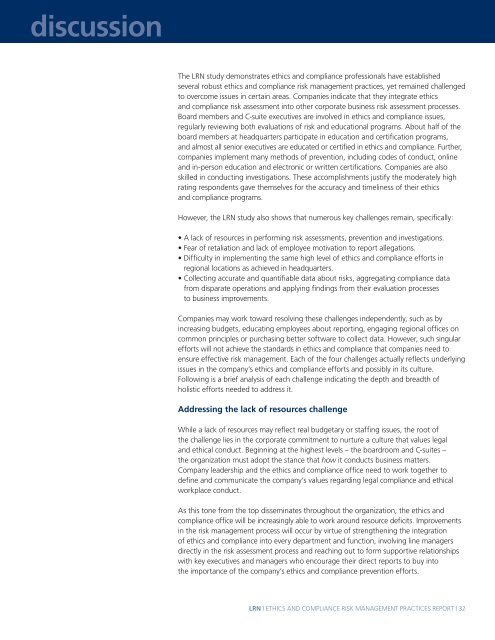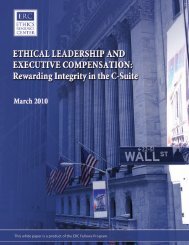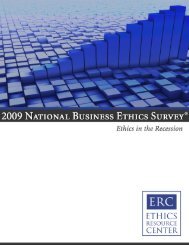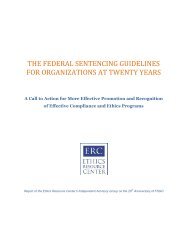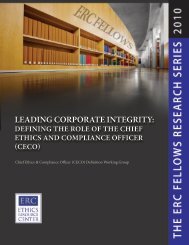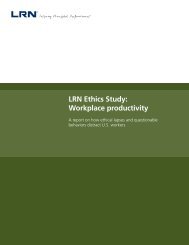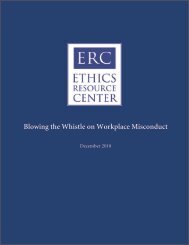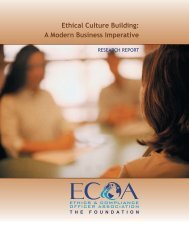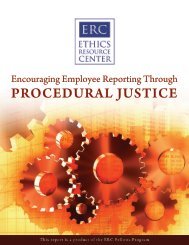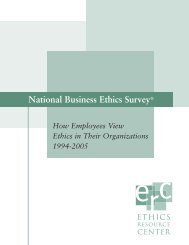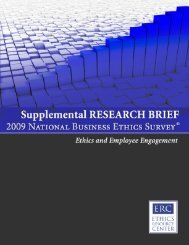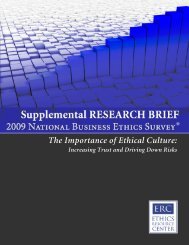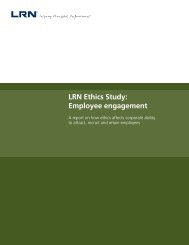LRN - Risk management Survey - Ethics Resource Center
LRN - Risk management Survey - Ethics Resource Center
LRN - Risk management Survey - Ethics Resource Center
- No tags were found...
You also want an ePaper? Increase the reach of your titles
YUMPU automatically turns print PDFs into web optimized ePapers that Google loves.
discussionThe <strong>LRN</strong> study demonstrates ethics and compliance professionals have establishedseveral robust ethics and compliance risk <strong>management</strong> practices, yet remained challengedto overcome issues in certain areas. Companies indicate that they integrate ethicsand compliance risk assessment into other corporate business risk assessment processes.Board members and C-suite executives are involved in ethics and compliance issues,regularly reviewing both evaluations of risk and educational programs. About half of theboard members at headquarters participate in education and certification programs,and almost all senior executives are educated or certified in ethics and compliance. Further,companies implement many methods of prevention, including codes of conduct, onlineand in-person education and electronic or written certifications. Companies are alsoskilled in conducting investigations. These accomplishments justify the moderately highrating respondents gave themselves for the accuracy and timeliness of their ethicsand compliance programs.However, the <strong>LRN</strong> study also shows that numerous key challenges remain, specifically:• A lack of resources in performing risk assessments, prevention and investigations.• Fear of retaliation and lack of employee motivation to report allegations.• Difficulty in implementing the same high level of ethics and compliance efforts inregional locations as achieved in headquarters.• Collecting accurate and quantifiable data about risks, aggregating compliance datafrom disparate operations and applying findings from their evaluation processesto business improvements.Companies may work toward resolving these challenges independently, such as byincreasing budgets, educating employees about reporting, engaging regional offices oncommon principles or purchasing better software to collect data. However, such singularefforts will not achieve the standards in ethics and compliance that companies need toensure effective risk <strong>management</strong>. Each of the four challenges actually reflects underlyingissues in the company’s ethics and compliance efforts and possibly in its culture.Following is a brief analysis of each challenge indicating the depth and breadth ofholistic efforts needed to address it.Addressing the lack of resources challengeWhile a lack of resources may reflect real budgetary or staffing issues, the root ofthe challenge lies in the corporate commitment to nurture a culture that values legaland ethical conduct. Beginning at the highest levels – the boardroom and C-suites –the organization must adopt the stance that how it conducts business matters.Company leadership and the ethics and compliance office need to work together todefine and communicate the company’s values regarding legal compliance and ethicalworkplace conduct.As this tone from the top disseminates throughout the organization, the ethics andcompliance office will be increasingly able to work around resource deficits. Improvementsin the risk <strong>management</strong> process will occur by virtue of strengthening the integrationof ethics and compliance into every department and function, involving line managersdirectly in the risk assessment process and reaching out to form supportive relationshipswith key executives and managers who encourage their direct reports to buy intothe importance of the company’s ethics and compliance prevention efforts.<strong>LRN</strong> | ETHICS AND COMPLIANCE RISK MANAGEMENT PRACTICES REPORT | 32


